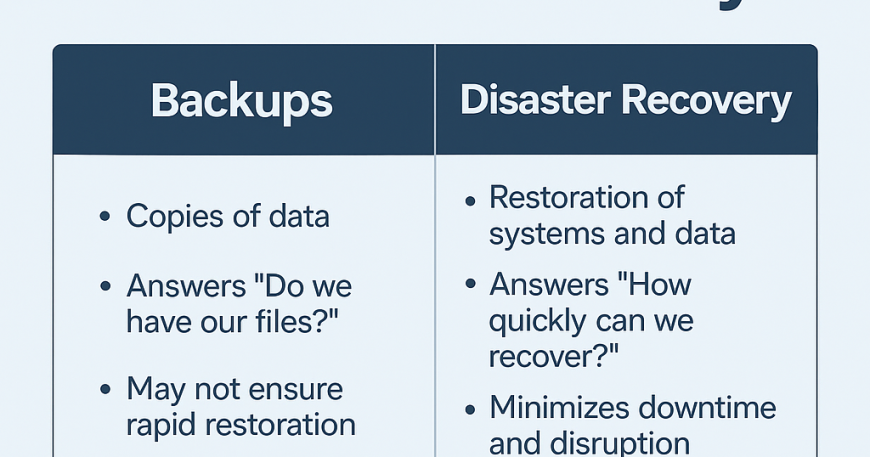Most small businesses breathe easy knowing they’ve “got backups.” But here’s the uncomfortable truth: a backup isn’t worth much if you can’t restore it quickly when you need it.
Backups vs. Disaster Recovery: What’s the Difference?
- Backups are copies of your data. They’re essential, but they only answer the question: “Do we still have a copy of our files somewhere?”
- Disaster Recovery (DR) is the process of getting your business back up and running after a major incident. It answers the bigger question: “How fast can we get back to normal?”
The Risks of “Just Having Backups”
- Unverified Restores
Plenty of businesses discover their backups are corrupted or incomplete only after a crisis. If you’re not testing restores, you don’t actually know if your data is safe. - Slow Recovery Times
Sure, your files are on a USB drive or in the cloud—but how long will it take to get everything reinstalled, reconfigured, and operational? Hours? Days? Weeks? - Business Continuity Gaps
It’s not just data—your staff need systems, applications, and networks working. Without a DR plan, you may have your data but no way to use it efficiently.
Why Disaster Recovery Matters
- Minimises Downtime: Every hour you’re offline costs money and credibility.
- Protects Reputation: Customers expect continuity; downtime makes you look unreliable.
- Covers More Than Just Data: DR planning includes systems, people, processes, and communication.
A Smarter Approach: Test, Plan, Protect
At LN I.T., we don’t just set up backups and walk away. We help businesses:
- Regularly test restores to make sure data can actually be recovered.
- Set realistic Recovery Time Objectives (RTOs) so you know how long you can afford to be down.
- Build simple disaster recovery plans that cover not just files, but your critical apps and systems.
- Keep multiple layers of backups (local + off-site/cloud) so you’re protected against fire, theft, or ransomware.
Final Word
Backups are the seatbelt. Disaster Recovery is the airbag. Both matter.
Don’t wait for the worst-case scenario to find out your “safety net” has holes in it. With the right planning, you can keep downtime to a minimum and protect both your business and your reputation.



